The Voyage of Columbus in the 15th Century
VerifiedAdded on 2022/11/26
|11
|2436
|132
AI Summary
This essay discusses the voyage of Columbus in the 15th century and the reasons behind it. It explores the impact of the discoveries on trade, commerce, and colonization. The essay also highlights the advantages of these explorations and their significance in history.
Contribute Materials
Your contribution can guide someone’s learning journey. Share your
documents today.
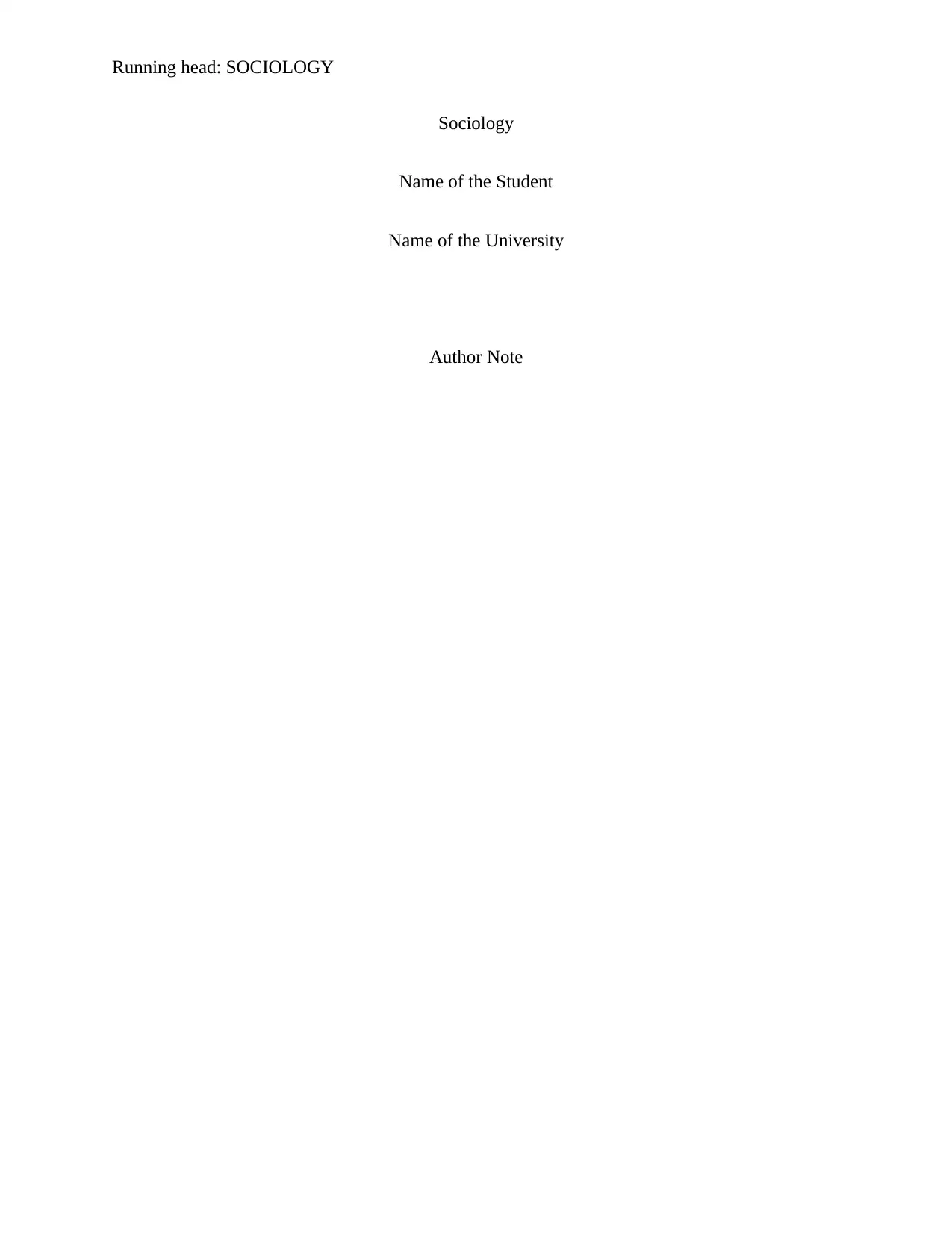
Running head: SOCIOLOGY
Sociology
Name of the Student
Name of the University
Author Note
Sociology
Name of the Student
Name of the University
Author Note
Secure Best Marks with AI Grader
Need help grading? Try our AI Grader for instant feedback on your assignments.
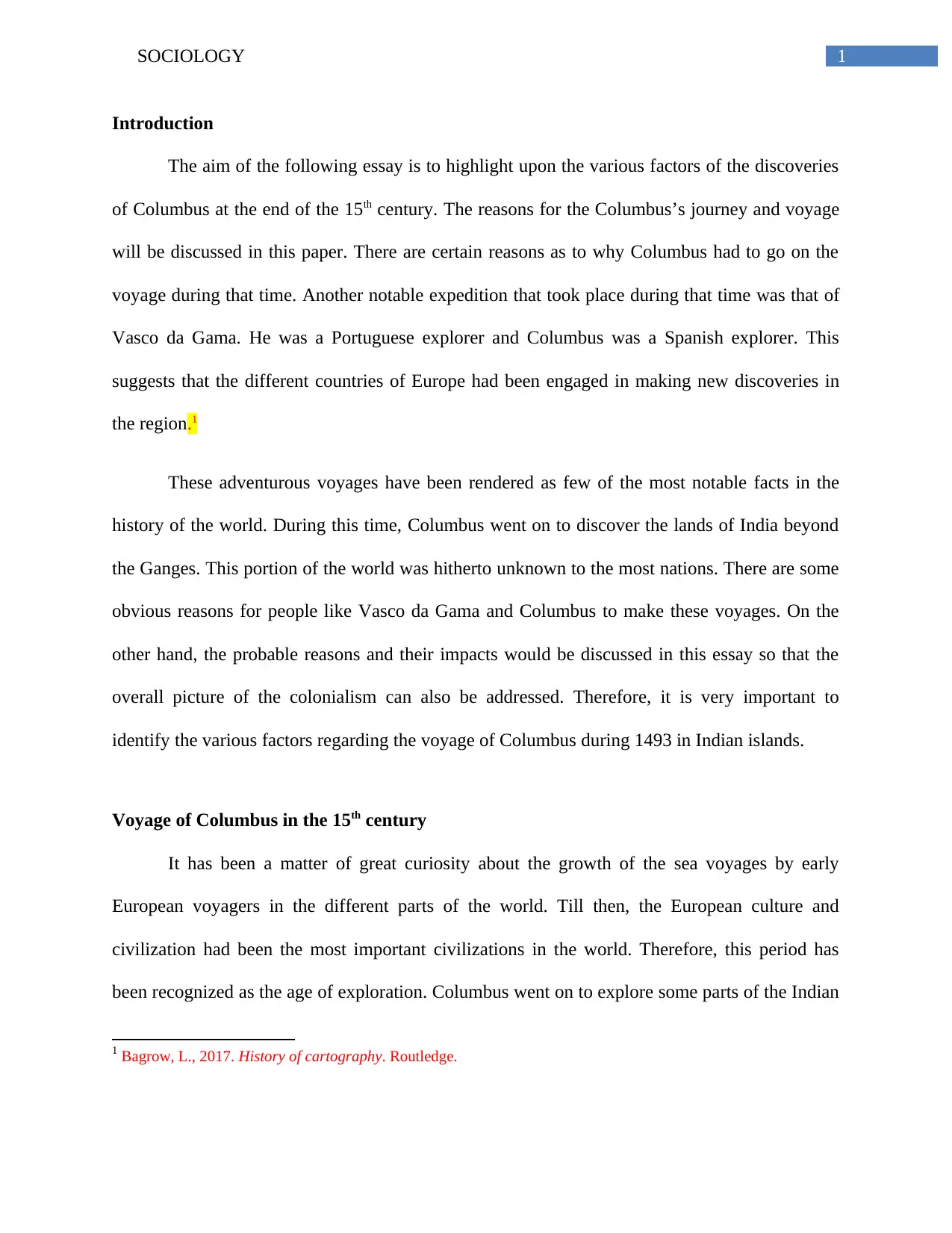
1SOCIOLOGY
Introduction
The aim of the following essay is to highlight upon the various factors of the discoveries
of Columbus at the end of the 15th century. The reasons for the Columbus’s journey and voyage
will be discussed in this paper. There are certain reasons as to why Columbus had to go on the
voyage during that time. Another notable expedition that took place during that time was that of
Vasco da Gama. He was a Portuguese explorer and Columbus was a Spanish explorer. This
suggests that the different countries of Europe had been engaged in making new discoveries in
the region.1
These adventurous voyages have been rendered as few of the most notable facts in the
history of the world. During this time, Columbus went on to discover the lands of India beyond
the Ganges. This portion of the world was hitherto unknown to the most nations. There are some
obvious reasons for people like Vasco da Gama and Columbus to make these voyages. On the
other hand, the probable reasons and their impacts would be discussed in this essay so that the
overall picture of the colonialism can also be addressed. Therefore, it is very important to
identify the various factors regarding the voyage of Columbus during 1493 in Indian islands.
Voyage of Columbus in the 15th century
It has been a matter of great curiosity about the growth of the sea voyages by early
European voyagers in the different parts of the world. Till then, the European culture and
civilization had been the most important civilizations in the world. Therefore, this period has
been recognized as the age of exploration. Columbus went on to explore some parts of the Indian
1 Bagrow, L., 2017. History of cartography. Routledge.
Introduction
The aim of the following essay is to highlight upon the various factors of the discoveries
of Columbus at the end of the 15th century. The reasons for the Columbus’s journey and voyage
will be discussed in this paper. There are certain reasons as to why Columbus had to go on the
voyage during that time. Another notable expedition that took place during that time was that of
Vasco da Gama. He was a Portuguese explorer and Columbus was a Spanish explorer. This
suggests that the different countries of Europe had been engaged in making new discoveries in
the region.1
These adventurous voyages have been rendered as few of the most notable facts in the
history of the world. During this time, Columbus went on to discover the lands of India beyond
the Ganges. This portion of the world was hitherto unknown to the most nations. There are some
obvious reasons for people like Vasco da Gama and Columbus to make these voyages. On the
other hand, the probable reasons and their impacts would be discussed in this essay so that the
overall picture of the colonialism can also be addressed. Therefore, it is very important to
identify the various factors regarding the voyage of Columbus during 1493 in Indian islands.
Voyage of Columbus in the 15th century
It has been a matter of great curiosity about the growth of the sea voyages by early
European voyagers in the different parts of the world. Till then, the European culture and
civilization had been the most important civilizations in the world. Therefore, this period has
been recognized as the age of exploration. Columbus went on to explore some parts of the Indian
1 Bagrow, L., 2017. History of cartography. Routledge.
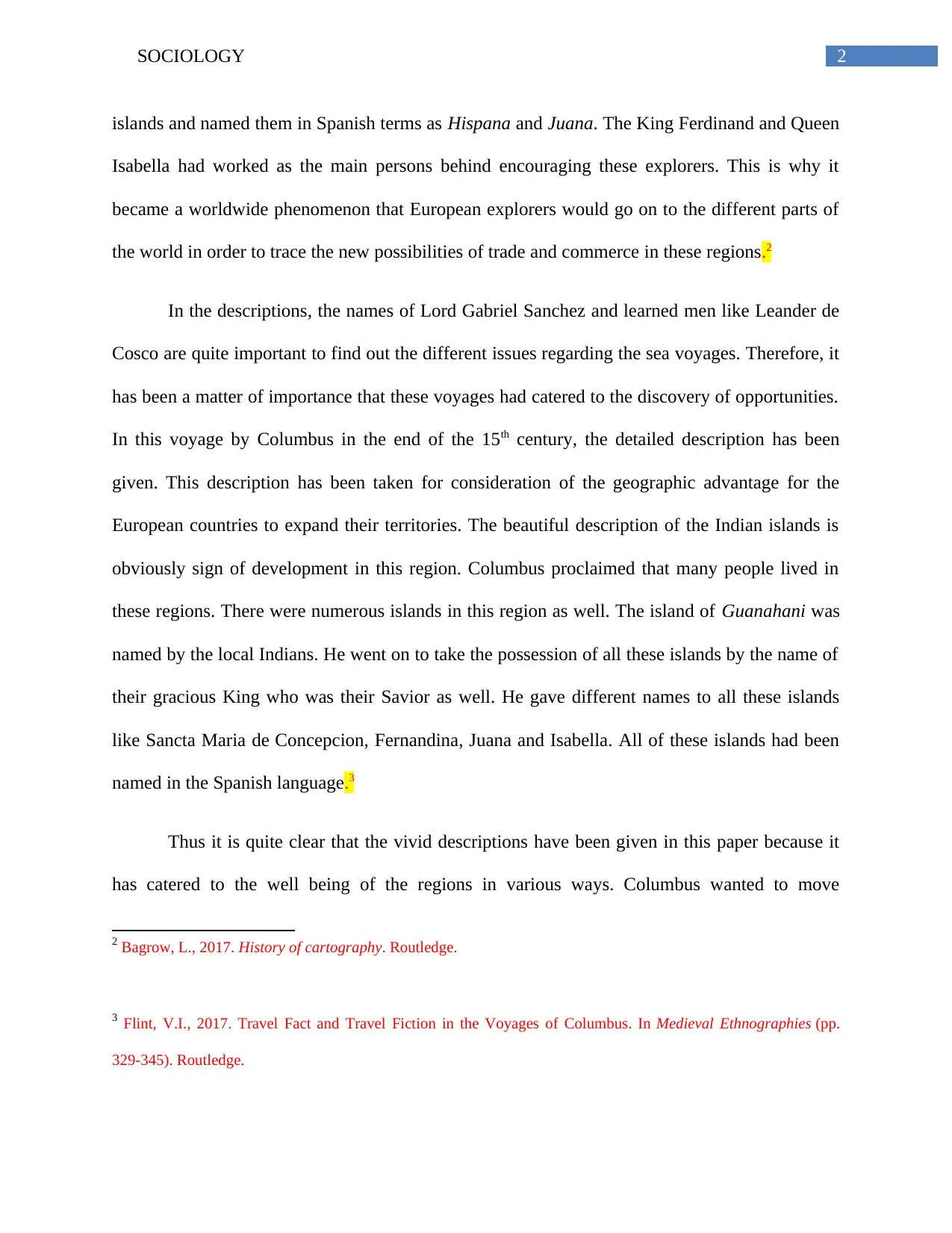
2SOCIOLOGY
islands and named them in Spanish terms as Hispana and Juana. The King Ferdinand and Queen
Isabella had worked as the main persons behind encouraging these explorers. This is why it
became a worldwide phenomenon that European explorers would go on to the different parts of
the world in order to trace the new possibilities of trade and commerce in these regions.2
In the descriptions, the names of Lord Gabriel Sanchez and learned men like Leander de
Cosco are quite important to find out the different issues regarding the sea voyages. Therefore, it
has been a matter of importance that these voyages had catered to the discovery of opportunities.
In this voyage by Columbus in the end of the 15th century, the detailed description has been
given. This description has been taken for consideration of the geographic advantage for the
European countries to expand their territories. The beautiful description of the Indian islands is
obviously sign of development in this region. Columbus proclaimed that many people lived in
these regions. There were numerous islands in this region as well. The island of Guanahani was
named by the local Indians. He went on to take the possession of all these islands by the name of
their gracious King who was their Savior as well. He gave different names to all these islands
like Sancta Maria de Concepcion, Fernandina, Juana and Isabella. All of these islands had been
named in the Spanish language.3
Thus it is quite clear that the vivid descriptions have been given in this paper because it
has catered to the well being of the regions in various ways. Columbus wanted to move
2 Bagrow, L., 2017. History of cartography. Routledge.
3 Flint, V.I., 2017. Travel Fact and Travel Fiction in the Voyages of Columbus. In Medieval Ethnographies (pp.
329-345). Routledge.
islands and named them in Spanish terms as Hispana and Juana. The King Ferdinand and Queen
Isabella had worked as the main persons behind encouraging these explorers. This is why it
became a worldwide phenomenon that European explorers would go on to the different parts of
the world in order to trace the new possibilities of trade and commerce in these regions.2
In the descriptions, the names of Lord Gabriel Sanchez and learned men like Leander de
Cosco are quite important to find out the different issues regarding the sea voyages. Therefore, it
has been a matter of importance that these voyages had catered to the discovery of opportunities.
In this voyage by Columbus in the end of the 15th century, the detailed description has been
given. This description has been taken for consideration of the geographic advantage for the
European countries to expand their territories. The beautiful description of the Indian islands is
obviously sign of development in this region. Columbus proclaimed that many people lived in
these regions. There were numerous islands in this region as well. The island of Guanahani was
named by the local Indians. He went on to take the possession of all these islands by the name of
their gracious King who was their Savior as well. He gave different names to all these islands
like Sancta Maria de Concepcion, Fernandina, Juana and Isabella. All of these islands had been
named in the Spanish language.3
Thus it is quite clear that the vivid descriptions have been given in this paper because it
has catered to the well being of the regions in various ways. Columbus wanted to move
2 Bagrow, L., 2017. History of cartography. Routledge.
3 Flint, V.I., 2017. Travel Fact and Travel Fiction in the Voyages of Columbus. In Medieval Ethnographies (pp.
329-345). Routledge.
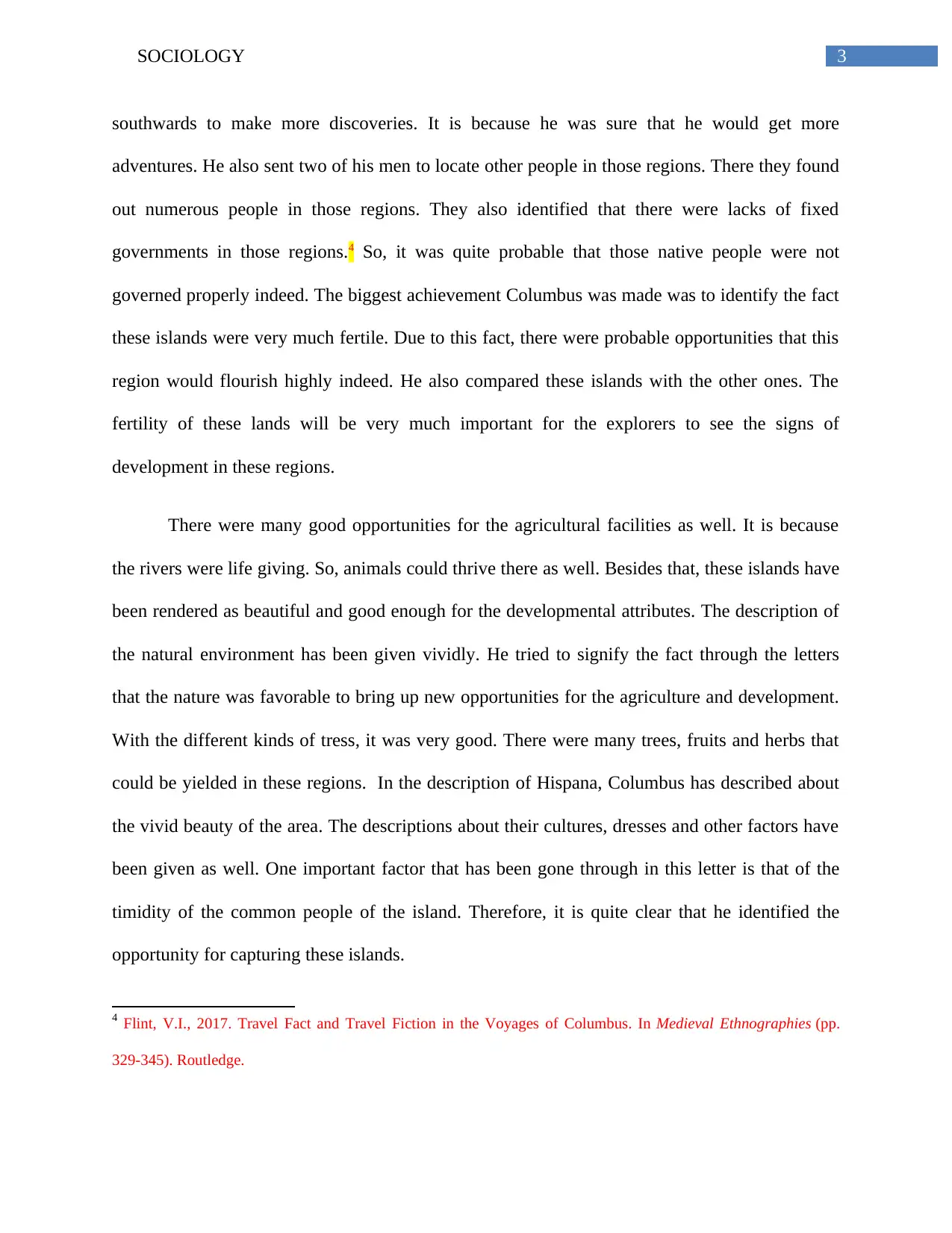
3SOCIOLOGY
southwards to make more discoveries. It is because he was sure that he would get more
adventures. He also sent two of his men to locate other people in those regions. There they found
out numerous people in those regions. They also identified that there were lacks of fixed
governments in those regions.4 So, it was quite probable that those native people were not
governed properly indeed. The biggest achievement Columbus was made was to identify the fact
these islands were very much fertile. Due to this fact, there were probable opportunities that this
region would flourish highly indeed. He also compared these islands with the other ones. The
fertility of these lands will be very much important for the explorers to see the signs of
development in these regions.
There were many good opportunities for the agricultural facilities as well. It is because
the rivers were life giving. So, animals could thrive there as well. Besides that, these islands have
been rendered as beautiful and good enough for the developmental attributes. The description of
the natural environment has been given vividly. He tried to signify the fact through the letters
that the nature was favorable to bring up new opportunities for the agriculture and development.
With the different kinds of tress, it was very good. There were many trees, fruits and herbs that
could be yielded in these regions. In the description of Hispana, Columbus has described about
the vivid beauty of the area. The descriptions about their cultures, dresses and other factors have
been given as well. One important factor that has been gone through in this letter is that of the
timidity of the common people of the island. Therefore, it is quite clear that he identified the
opportunity for capturing these islands.
4 Flint, V.I., 2017. Travel Fact and Travel Fiction in the Voyages of Columbus. In Medieval Ethnographies (pp.
329-345). Routledge.
southwards to make more discoveries. It is because he was sure that he would get more
adventures. He also sent two of his men to locate other people in those regions. There they found
out numerous people in those regions. They also identified that there were lacks of fixed
governments in those regions.4 So, it was quite probable that those native people were not
governed properly indeed. The biggest achievement Columbus was made was to identify the fact
these islands were very much fertile. Due to this fact, there were probable opportunities that this
region would flourish highly indeed. He also compared these islands with the other ones. The
fertility of these lands will be very much important for the explorers to see the signs of
development in these regions.
There were many good opportunities for the agricultural facilities as well. It is because
the rivers were life giving. So, animals could thrive there as well. Besides that, these islands have
been rendered as beautiful and good enough for the developmental attributes. The description of
the natural environment has been given vividly. He tried to signify the fact through the letters
that the nature was favorable to bring up new opportunities for the agriculture and development.
With the different kinds of tress, it was very good. There were many trees, fruits and herbs that
could be yielded in these regions. In the description of Hispana, Columbus has described about
the vivid beauty of the area. The descriptions about their cultures, dresses and other factors have
been given as well. One important factor that has been gone through in this letter is that of the
timidity of the common people of the island. Therefore, it is quite clear that he identified the
opportunity for capturing these islands.
4 Flint, V.I., 2017. Travel Fact and Travel Fiction in the Voyages of Columbus. In Medieval Ethnographies (pp.
329-345). Routledge.
Secure Best Marks with AI Grader
Need help grading? Try our AI Grader for instant feedback on your assignments.
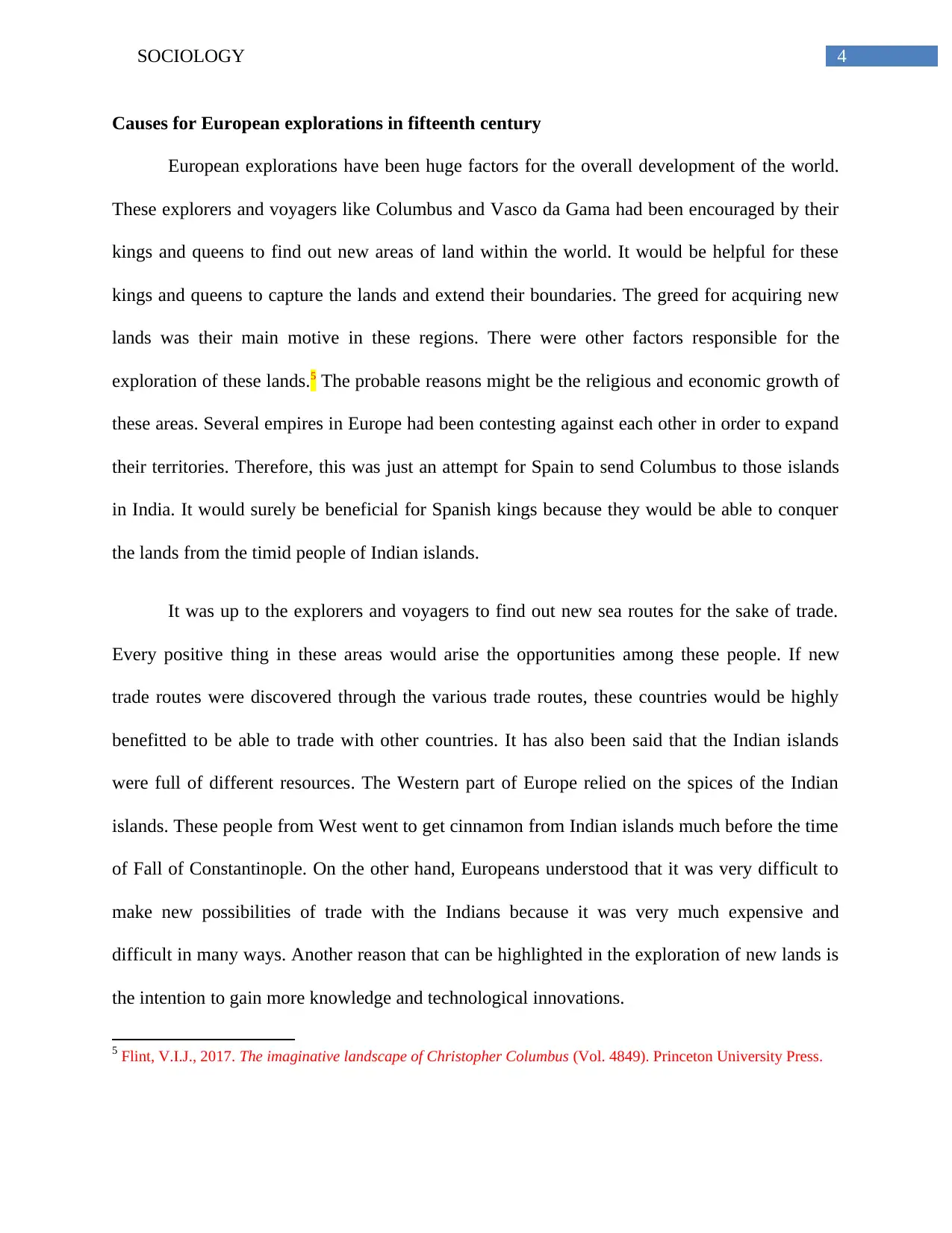
4SOCIOLOGY
Causes for European explorations in fifteenth century
European explorations have been huge factors for the overall development of the world.
These explorers and voyagers like Columbus and Vasco da Gama had been encouraged by their
kings and queens to find out new areas of land within the world. It would be helpful for these
kings and queens to capture the lands and extend their boundaries. The greed for acquiring new
lands was their main motive in these regions. There were other factors responsible for the
exploration of these lands.5 The probable reasons might be the religious and economic growth of
these areas. Several empires in Europe had been contesting against each other in order to expand
their territories. Therefore, this was just an attempt for Spain to send Columbus to those islands
in India. It would surely be beneficial for Spanish kings because they would be able to conquer
the lands from the timid people of Indian islands.
It was up to the explorers and voyagers to find out new sea routes for the sake of trade.
Every positive thing in these areas would arise the opportunities among these people. If new
trade routes were discovered through the various trade routes, these countries would be highly
benefitted to be able to trade with other countries. It has also been said that the Indian islands
were full of different resources. The Western part of Europe relied on the spices of the Indian
islands. These people from West went to get cinnamon from Indian islands much before the time
of Fall of Constantinople. On the other hand, Europeans understood that it was very difficult to
make new possibilities of trade with the Indians because it was very much expensive and
difficult in many ways. Another reason that can be highlighted in the exploration of new lands is
the intention to gain more knowledge and technological innovations.
5 Flint, V.I.J., 2017. The imaginative landscape of Christopher Columbus (Vol. 4849). Princeton University Press.
Causes for European explorations in fifteenth century
European explorations have been huge factors for the overall development of the world.
These explorers and voyagers like Columbus and Vasco da Gama had been encouraged by their
kings and queens to find out new areas of land within the world. It would be helpful for these
kings and queens to capture the lands and extend their boundaries. The greed for acquiring new
lands was their main motive in these regions. There were other factors responsible for the
exploration of these lands.5 The probable reasons might be the religious and economic growth of
these areas. Several empires in Europe had been contesting against each other in order to expand
their territories. Therefore, this was just an attempt for Spain to send Columbus to those islands
in India. It would surely be beneficial for Spanish kings because they would be able to conquer
the lands from the timid people of Indian islands.
It was up to the explorers and voyagers to find out new sea routes for the sake of trade.
Every positive thing in these areas would arise the opportunities among these people. If new
trade routes were discovered through the various trade routes, these countries would be highly
benefitted to be able to trade with other countries. It has also been said that the Indian islands
were full of different resources. The Western part of Europe relied on the spices of the Indian
islands. These people from West went to get cinnamon from Indian islands much before the time
of Fall of Constantinople. On the other hand, Europeans understood that it was very difficult to
make new possibilities of trade with the Indians because it was very much expensive and
difficult in many ways. Another reason that can be highlighted in the exploration of new lands is
the intention to gain more knowledge and technological innovations.
5 Flint, V.I.J., 2017. The imaginative landscape of Christopher Columbus (Vol. 4849). Princeton University Press.
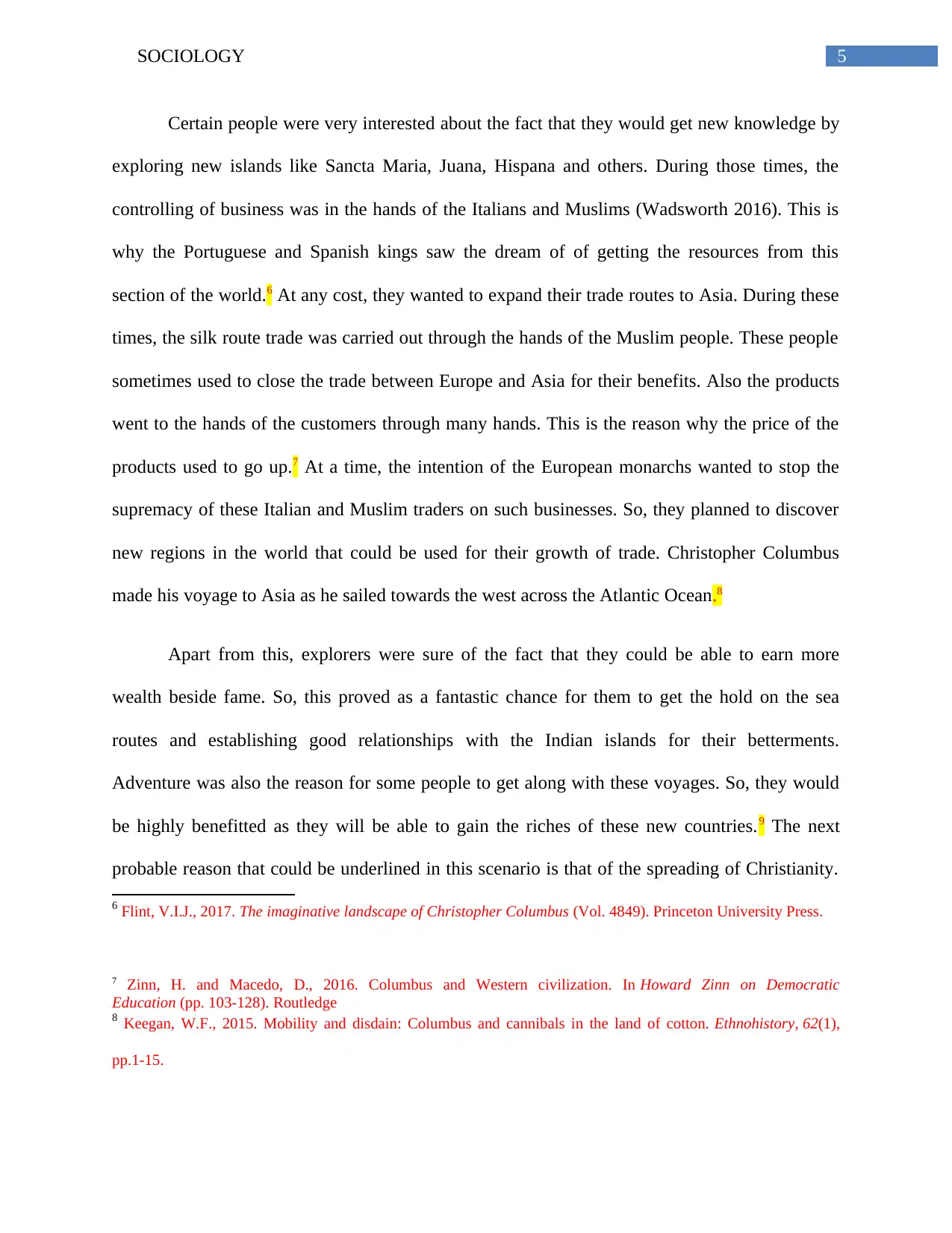
5SOCIOLOGY
Certain people were very interested about the fact that they would get new knowledge by
exploring new islands like Sancta Maria, Juana, Hispana and others. During those times, the
controlling of business was in the hands of the Italians and Muslims (Wadsworth 2016). This is
why the Portuguese and Spanish kings saw the dream of of getting the resources from this
section of the world.6 At any cost, they wanted to expand their trade routes to Asia. During these
times, the silk route trade was carried out through the hands of the Muslim people. These people
sometimes used to close the trade between Europe and Asia for their benefits. Also the products
went to the hands of the customers through many hands. This is the reason why the price of the
products used to go up.7 At a time, the intention of the European monarchs wanted to stop the
supremacy of these Italian and Muslim traders on such businesses. So, they planned to discover
new regions in the world that could be used for their growth of trade. Christopher Columbus
made his voyage to Asia as he sailed towards the west across the Atlantic Ocean.8
Apart from this, explorers were sure of the fact that they could be able to earn more
wealth beside fame. So, this proved as a fantastic chance for them to get the hold on the sea
routes and establishing good relationships with the Indian islands for their betterments.
Adventure was also the reason for some people to get along with these voyages. So, they would
be highly benefitted as they will be able to gain the riches of these new countries.9 The next
probable reason that could be underlined in this scenario is that of the spreading of Christianity.
6 Flint, V.I.J., 2017. The imaginative landscape of Christopher Columbus (Vol. 4849). Princeton University Press.
7 Zinn, H. and Macedo, D., 2016. Columbus and Western civilization. In Howard Zinn on Democratic
Education (pp. 103-128). Routledge
8 Keegan, W.F., 2015. Mobility and disdain: Columbus and cannibals in the land of cotton. Ethnohistory, 62(1),
pp.1-15.
Certain people were very interested about the fact that they would get new knowledge by
exploring new islands like Sancta Maria, Juana, Hispana and others. During those times, the
controlling of business was in the hands of the Italians and Muslims (Wadsworth 2016). This is
why the Portuguese and Spanish kings saw the dream of of getting the resources from this
section of the world.6 At any cost, they wanted to expand their trade routes to Asia. During these
times, the silk route trade was carried out through the hands of the Muslim people. These people
sometimes used to close the trade between Europe and Asia for their benefits. Also the products
went to the hands of the customers through many hands. This is the reason why the price of the
products used to go up.7 At a time, the intention of the European monarchs wanted to stop the
supremacy of these Italian and Muslim traders on such businesses. So, they planned to discover
new regions in the world that could be used for their growth of trade. Christopher Columbus
made his voyage to Asia as he sailed towards the west across the Atlantic Ocean.8
Apart from this, explorers were sure of the fact that they could be able to earn more
wealth beside fame. So, this proved as a fantastic chance for them to get the hold on the sea
routes and establishing good relationships with the Indian islands for their betterments.
Adventure was also the reason for some people to get along with these voyages. So, they would
be highly benefitted as they will be able to gain the riches of these new countries.9 The next
probable reason that could be underlined in this scenario is that of the spreading of Christianity.
6 Flint, V.I.J., 2017. The imaginative landscape of Christopher Columbus (Vol. 4849). Princeton University Press.
7 Zinn, H. and Macedo, D., 2016. Columbus and Western civilization. In Howard Zinn on Democratic
Education (pp. 103-128). Routledge
8 Keegan, W.F., 2015. Mobility and disdain: Columbus and cannibals in the land of cotton. Ethnohistory, 62(1),
pp.1-15.
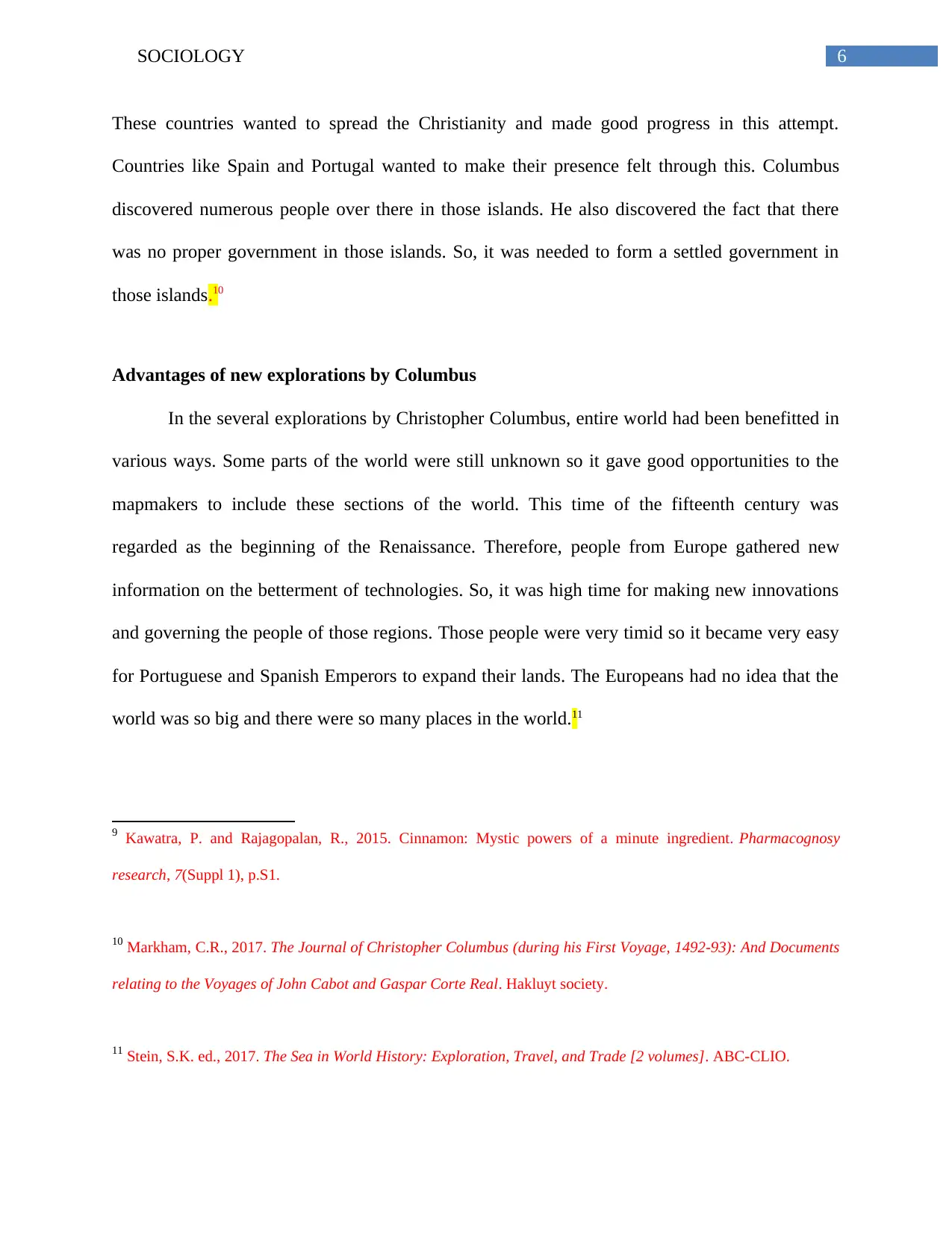
6SOCIOLOGY
These countries wanted to spread the Christianity and made good progress in this attempt.
Countries like Spain and Portugal wanted to make their presence felt through this. Columbus
discovered numerous people over there in those islands. He also discovered the fact that there
was no proper government in those islands. So, it was needed to form a settled government in
those islands.10
Advantages of new explorations by Columbus
In the several explorations by Christopher Columbus, entire world had been benefitted in
various ways. Some parts of the world were still unknown so it gave good opportunities to the
mapmakers to include these sections of the world. This time of the fifteenth century was
regarded as the beginning of the Renaissance. Therefore, people from Europe gathered new
information on the betterment of technologies. So, it was high time for making new innovations
and governing the people of those regions. Those people were very timid so it became very easy
for Portuguese and Spanish Emperors to expand their lands. The Europeans had no idea that the
world was so big and there were so many places in the world.11
9 Kawatra, P. and Rajagopalan, R., 2015. Cinnamon: Mystic powers of a minute ingredient. Pharmacognosy
research, 7(Suppl 1), p.S1.
10 Markham, C.R., 2017. The Journal of Christopher Columbus (during his First Voyage, 1492-93): And Documents
relating to the Voyages of John Cabot and Gaspar Corte Real. Hakluyt society.
11 Stein, S.K. ed., 2017. The Sea in World History: Exploration, Travel, and Trade [2 volumes]. ABC-CLIO.
These countries wanted to spread the Christianity and made good progress in this attempt.
Countries like Spain and Portugal wanted to make their presence felt through this. Columbus
discovered numerous people over there in those islands. He also discovered the fact that there
was no proper government in those islands. So, it was needed to form a settled government in
those islands.10
Advantages of new explorations by Columbus
In the several explorations by Christopher Columbus, entire world had been benefitted in
various ways. Some parts of the world were still unknown so it gave good opportunities to the
mapmakers to include these sections of the world. This time of the fifteenth century was
regarded as the beginning of the Renaissance. Therefore, people from Europe gathered new
information on the betterment of technologies. So, it was high time for making new innovations
and governing the people of those regions. Those people were very timid so it became very easy
for Portuguese and Spanish Emperors to expand their lands. The Europeans had no idea that the
world was so big and there were so many places in the world.11
9 Kawatra, P. and Rajagopalan, R., 2015. Cinnamon: Mystic powers of a minute ingredient. Pharmacognosy
research, 7(Suppl 1), p.S1.
10 Markham, C.R., 2017. The Journal of Christopher Columbus (during his First Voyage, 1492-93): And Documents
relating to the Voyages of John Cabot and Gaspar Corte Real. Hakluyt society.
11 Stein, S.K. ed., 2017. The Sea in World History: Exploration, Travel, and Trade [2 volumes]. ABC-CLIO.
Paraphrase This Document
Need a fresh take? Get an instant paraphrase of this document with our AI Paraphraser
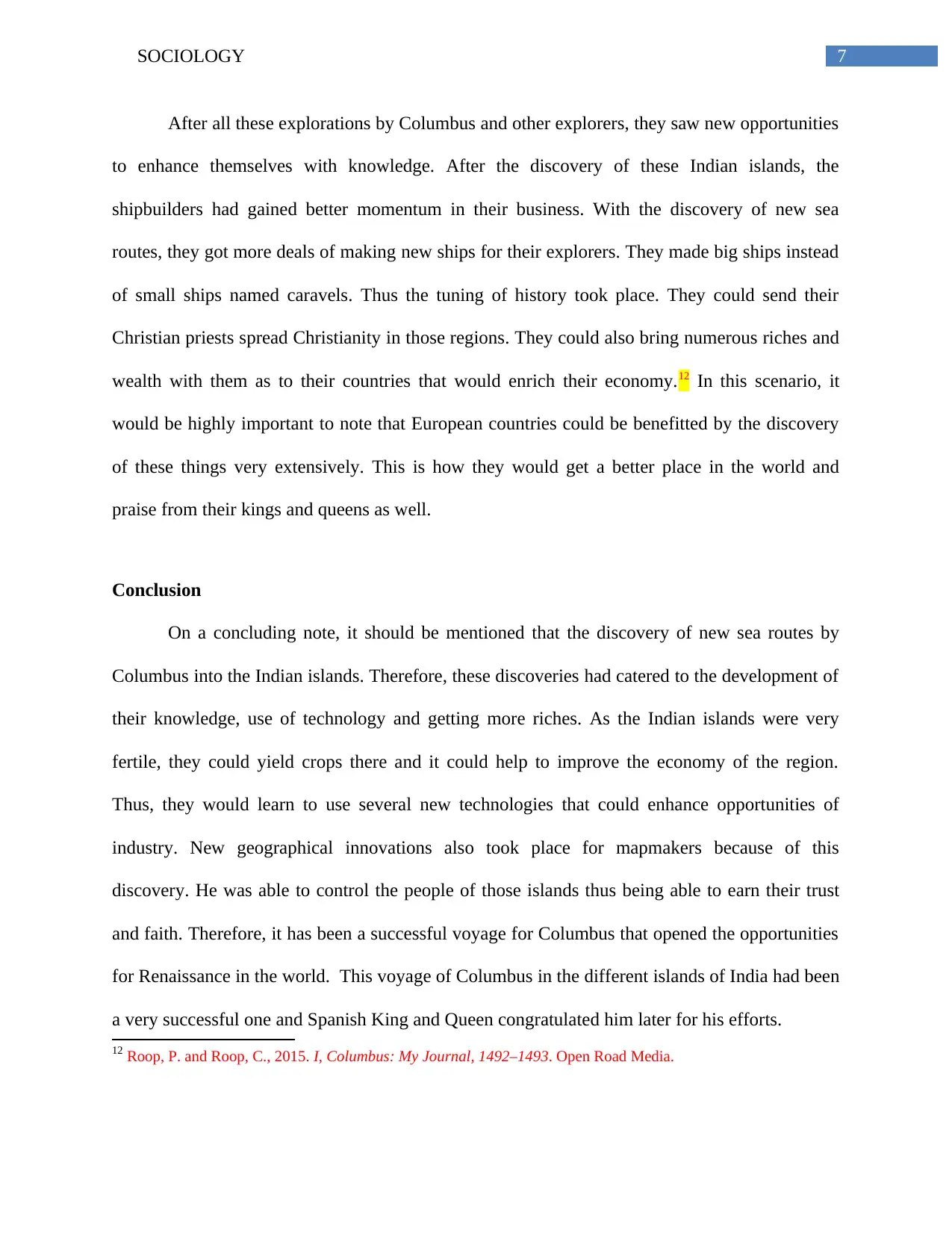
7SOCIOLOGY
After all these explorations by Columbus and other explorers, they saw new opportunities
to enhance themselves with knowledge. After the discovery of these Indian islands, the
shipbuilders had gained better momentum in their business. With the discovery of new sea
routes, they got more deals of making new ships for their explorers. They made big ships instead
of small ships named caravels. Thus the tuning of history took place. They could send their
Christian priests spread Christianity in those regions. They could also bring numerous riches and
wealth with them as to their countries that would enrich their economy.12 In this scenario, it
would be highly important to note that European countries could be benefitted by the discovery
of these things very extensively. This is how they would get a better place in the world and
praise from their kings and queens as well.
Conclusion
On a concluding note, it should be mentioned that the discovery of new sea routes by
Columbus into the Indian islands. Therefore, these discoveries had catered to the development of
their knowledge, use of technology and getting more riches. As the Indian islands were very
fertile, they could yield crops there and it could help to improve the economy of the region.
Thus, they would learn to use several new technologies that could enhance opportunities of
industry. New geographical innovations also took place for mapmakers because of this
discovery. He was able to control the people of those islands thus being able to earn their trust
and faith. Therefore, it has been a successful voyage for Columbus that opened the opportunities
for Renaissance in the world. This voyage of Columbus in the different islands of India had been
a very successful one and Spanish King and Queen congratulated him later for his efforts.
12 Roop, P. and Roop, C., 2015. I, Columbus: My Journal, 1492–1493. Open Road Media.
After all these explorations by Columbus and other explorers, they saw new opportunities
to enhance themselves with knowledge. After the discovery of these Indian islands, the
shipbuilders had gained better momentum in their business. With the discovery of new sea
routes, they got more deals of making new ships for their explorers. They made big ships instead
of small ships named caravels. Thus the tuning of history took place. They could send their
Christian priests spread Christianity in those regions. They could also bring numerous riches and
wealth with them as to their countries that would enrich their economy.12 In this scenario, it
would be highly important to note that European countries could be benefitted by the discovery
of these things very extensively. This is how they would get a better place in the world and
praise from their kings and queens as well.
Conclusion
On a concluding note, it should be mentioned that the discovery of new sea routes by
Columbus into the Indian islands. Therefore, these discoveries had catered to the development of
their knowledge, use of technology and getting more riches. As the Indian islands were very
fertile, they could yield crops there and it could help to improve the economy of the region.
Thus, they would learn to use several new technologies that could enhance opportunities of
industry. New geographical innovations also took place for mapmakers because of this
discovery. He was able to control the people of those islands thus being able to earn their trust
and faith. Therefore, it has been a successful voyage for Columbus that opened the opportunities
for Renaissance in the world. This voyage of Columbus in the different islands of India had been
a very successful one and Spanish King and Queen congratulated him later for his efforts.
12 Roop, P. and Roop, C., 2015. I, Columbus: My Journal, 1492–1493. Open Road Media.

8SOCIOLOGY
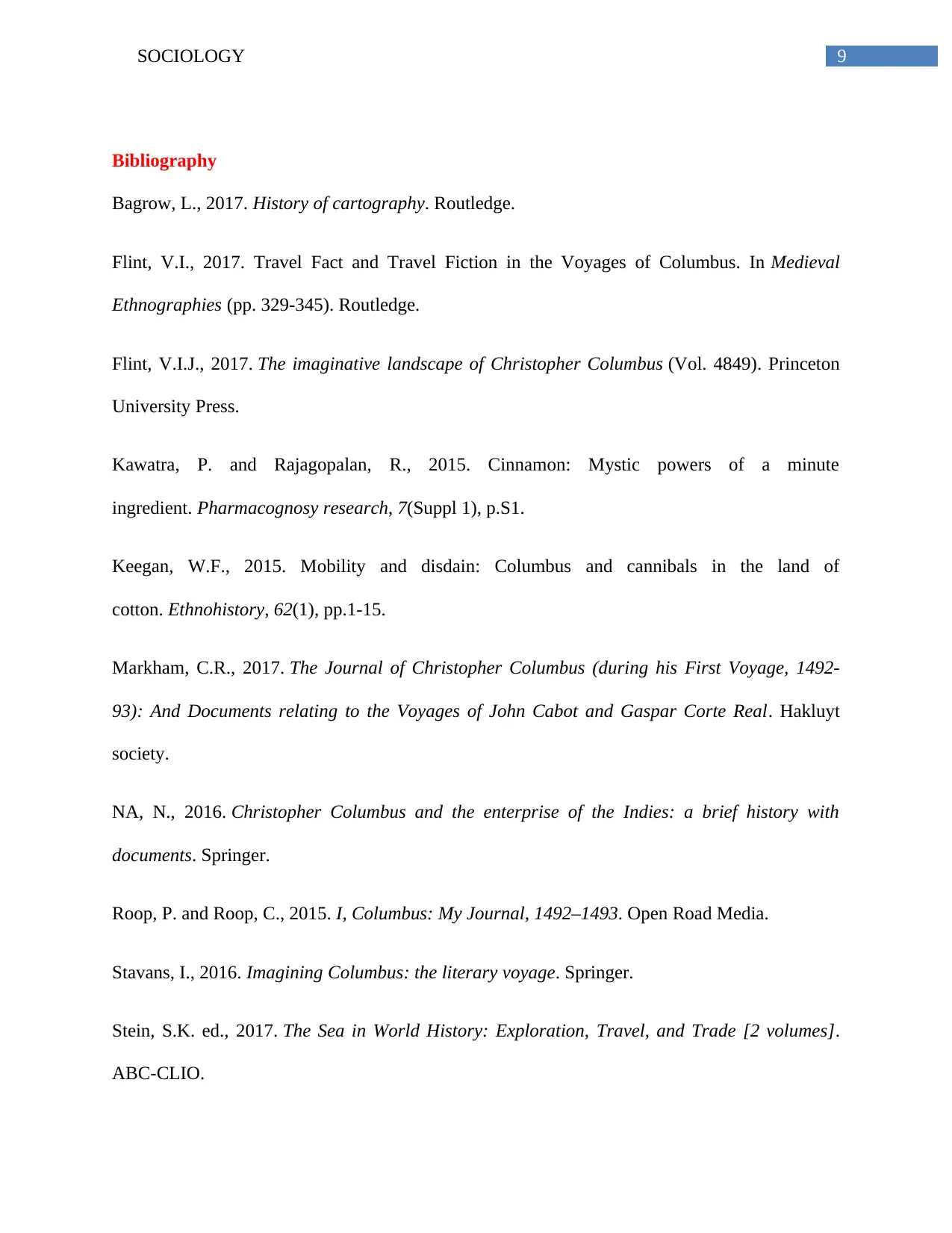
9SOCIOLOGY
Bibliography
Bagrow, L., 2017. History of cartography. Routledge.
Flint, V.I., 2017. Travel Fact and Travel Fiction in the Voyages of Columbus. In Medieval
Ethnographies (pp. 329-345). Routledge.
Flint, V.I.J., 2017. The imaginative landscape of Christopher Columbus (Vol. 4849). Princeton
University Press.
Kawatra, P. and Rajagopalan, R., 2015. Cinnamon: Mystic powers of a minute
ingredient. Pharmacognosy research, 7(Suppl 1), p.S1.
Keegan, W.F., 2015. Mobility and disdain: Columbus and cannibals in the land of
cotton. Ethnohistory, 62(1), pp.1-15.
Markham, C.R., 2017. The Journal of Christopher Columbus (during his First Voyage, 1492-
93): And Documents relating to the Voyages of John Cabot and Gaspar Corte Real. Hakluyt
society.
NA, N., 2016. Christopher Columbus and the enterprise of the Indies: a brief history with
documents. Springer.
Roop, P. and Roop, C., 2015. I, Columbus: My Journal, 1492–1493. Open Road Media.
Stavans, I., 2016. Imagining Columbus: the literary voyage. Springer.
Stein, S.K. ed., 2017. The Sea in World History: Exploration, Travel, and Trade [2 volumes].
ABC-CLIO.
Bibliography
Bagrow, L., 2017. History of cartography. Routledge.
Flint, V.I., 2017. Travel Fact and Travel Fiction in the Voyages of Columbus. In Medieval
Ethnographies (pp. 329-345). Routledge.
Flint, V.I.J., 2017. The imaginative landscape of Christopher Columbus (Vol. 4849). Princeton
University Press.
Kawatra, P. and Rajagopalan, R., 2015. Cinnamon: Mystic powers of a minute
ingredient. Pharmacognosy research, 7(Suppl 1), p.S1.
Keegan, W.F., 2015. Mobility and disdain: Columbus and cannibals in the land of
cotton. Ethnohistory, 62(1), pp.1-15.
Markham, C.R., 2017. The Journal of Christopher Columbus (during his First Voyage, 1492-
93): And Documents relating to the Voyages of John Cabot and Gaspar Corte Real. Hakluyt
society.
NA, N., 2016. Christopher Columbus and the enterprise of the Indies: a brief history with
documents. Springer.
Roop, P. and Roop, C., 2015. I, Columbus: My Journal, 1492–1493. Open Road Media.
Stavans, I., 2016. Imagining Columbus: the literary voyage. Springer.
Stein, S.K. ed., 2017. The Sea in World History: Exploration, Travel, and Trade [2 volumes].
ABC-CLIO.
Secure Best Marks with AI Grader
Need help grading? Try our AI Grader for instant feedback on your assignments.
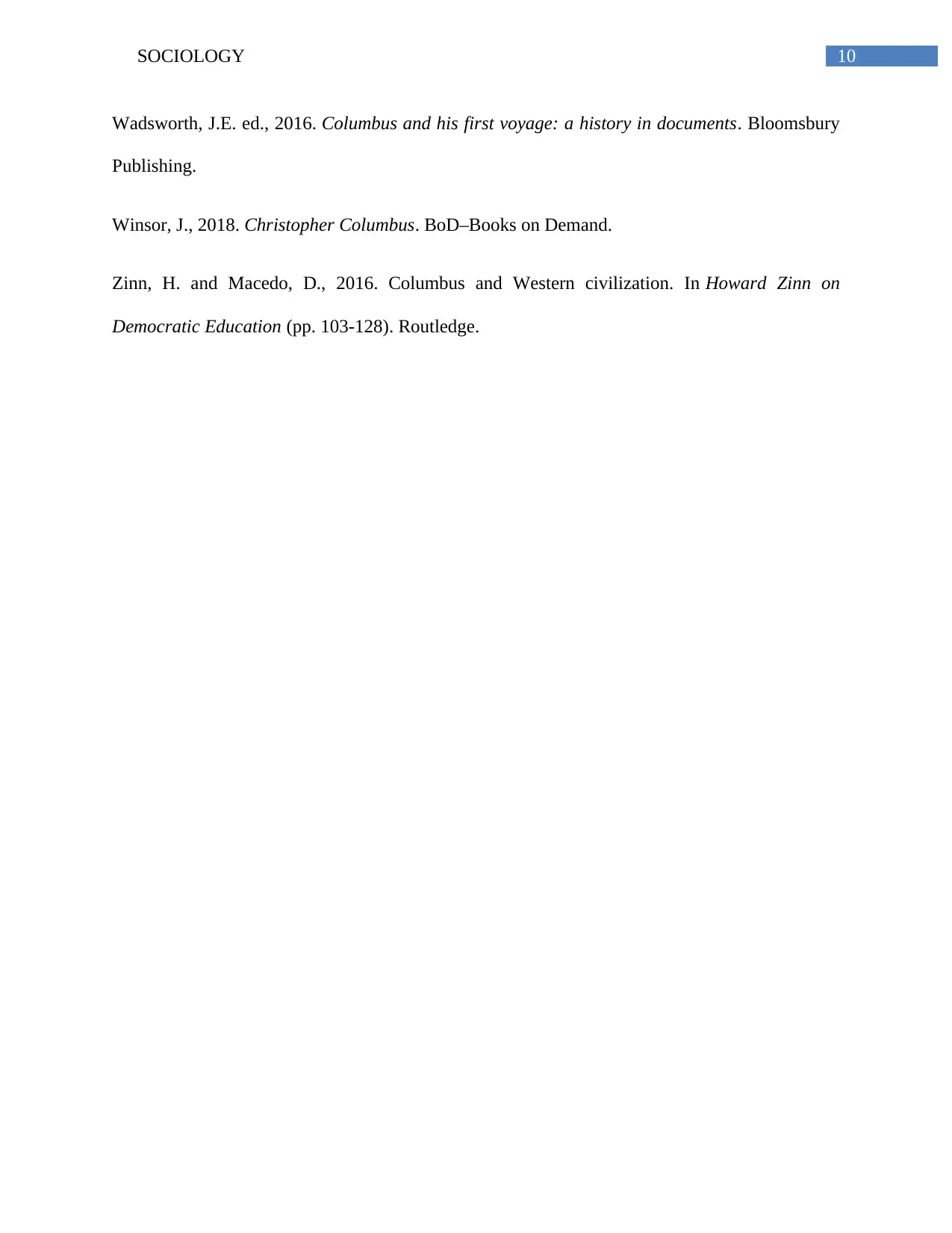
10SOCIOLOGY
Wadsworth, J.E. ed., 2016. Columbus and his first voyage: a history in documents. Bloomsbury
Publishing.
Winsor, J., 2018. Christopher Columbus. BoD–Books on Demand.
Zinn, H. and Macedo, D., 2016. Columbus and Western civilization. In Howard Zinn on
Democratic Education (pp. 103-128). Routledge.
Wadsworth, J.E. ed., 2016. Columbus and his first voyage: a history in documents. Bloomsbury
Publishing.
Winsor, J., 2018. Christopher Columbus. BoD–Books on Demand.
Zinn, H. and Macedo, D., 2016. Columbus and Western civilization. In Howard Zinn on
Democratic Education (pp. 103-128). Routledge.
1 out of 11
Related Documents
Your All-in-One AI-Powered Toolkit for Academic Success.
+13062052269
info@desklib.com
Available 24*7 on WhatsApp / Email
![[object Object]](/_next/static/media/star-bottom.7253800d.svg)
Unlock your academic potential
© 2024 | Zucol Services PVT LTD | All rights reserved.





